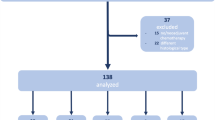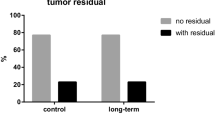Abstract
The aim of this study is to investigate the significance of lymphatic space invasion (LSI) and tumor VEGF-C expression in the lymphatic spread of ovarian cancer. By performing immunostaining using human ovarian cancer specimens, we first investigated the association between the extent of LSI and tumor VEGF-C expression, tumor lymphangiogenesis, or the lymphatic metastasis. Moreover, by performing in vitro and in vivo experiments, we elucidated the role of VEGF-C in tumor lymphangiogenesis and lymph node metastasis as well as its role as a therapeutic target in ovarian cancer. The presence of LSI was associated with lymph node metastasis in patients with ovarian cancer. VEGF-C overexpression was significantly associated with the increased LSI and LVD in ovarian cancer. VEGF-C stimulated the lymphangiogenesis in vitro, induced the new lymph vessel formation, and increased the lymph node metastasis in mice models of ovarian cancer. The attenuation of VEGF-C expression by the treatment with mTORC1 inhibitor significantly inhibited lymphangiogenesis, and decreased lymph node metastasis in mice models of ovarian cancer. The presence of LSI is an indicator of nodal metastasis and is associated with higher tumor VEGF-C expression and worse clinical outcome of ovarian cancer patients. VEGF-C plays a crucial role in tumor lymphangiogenesis and lymph node metastasis of ovarian cancer.




Similar content being viewed by others
Abbreviations
- VEGF-C:
-
Vascular endothelial growth factor-C
- VEGFR-3:
-
Vascular endothelial growth factor recepotor-3
- LVEPCs:
-
Lymphatic vascular endothelial progenitor cells
- LVD:
-
Lymphatic vessel density
- LSI:
-
Lymphatic space invasion
- HMVEC-dLy:
-
Human dermal lymphatic microvascular endothelial cells
- ELISA:
-
Enzyme-linked immunosorbent assay
- LYVE-1:
-
Lymphatic vessel endothelial hyaluronan receptor 1 cell marker
- FACS:
-
Fluorescence activated cell sorting
- mTORC1:
-
Mammalian target of rapamycin complex 1
References
Siegel R, Naishadham D, Jemal A (2013) Cancer statistics. CA Cancer J Clin 63(1):11–30
Jemal A, Siegel R, Xu J et al (2010) Cancer statistics. CA Cancer J Clin 60(5):277–300
Gatta G, Lasota MB, Verdecchia A, EUROCARE Working Group (1998) Survival of European women with gynaecological tumours, during the period 1978-1989. Eur J Cancer 34(14):2218–2225
Burger RA, Brady MF, Bookman MA et al (2011) Incorporation of bevacizumab in the primary treatment of ovarian cancer. N Engl J Med 365(26):2473–2483
Mikami M (2014) Role of lymphadenectomy for ovarian cancer. J Gynecol Oncol 25(4):279–281
Chan JK, Munro EG, Cheung MK et al (2007) Association of lymphadenectomy and survival in stage I ovarian cancer patients. Obstet Gynecol 109(1):12–19
Alitalo K (2011) The lymphatic vasculature in disease. Nat Med 17(11):1371–1380
Kim HS, Park NH, Chung HH et al (2008) Significance of preoperative serum CA-125 levels in the prediction of lymph node metastasis in epithelial ovarian cancer. Acta Obstet Gynecol Scand 87(11):1136–1142
Li AJ, Madden AC, Cass I et al (2004) The prognostic significance of thrombocytosis in epithelial ovarian carcinoma. Gynecol Oncol 92(1):211–214
Powless CA, Aletti GD, Bakkum-Gamez JN et al (2011) Risk factors for lymph node metastasis in apparent early-stage epithelial ovarian cancer: implications for surgical staging. Gynecol Oncol 122(3):536–540
Matsuo K, Sheridan TB, Yoshino K et al (2012) Significance of lymphovascular space invasion in epithelial ovarian cancer. Cancer Med 1(2):156–164
Birner P, Obermair A, Schindl M et al (2001) Selective immunohistochemical staining of blood and lymphatic vessels reveals independent prognostic influence of blood and lymphatic vessel invasion in early-stage cervical cancer. Clin Cancer Res 7(1):93–97
Weber SK, Sauerwald A, Polcher M et al (2012) Detection of lymphovascular invasion by D2-40 (podoplanin) immunoexpression in endometrial cancer. Int J Gynecol Cancer 22(8):1442–1448
Decio A, Taraboletti G, Patton V et al (2014) Vascular endothelial growth factor c promotes ovarian carcinoma progression through paracrine and autocrine mechanisms. Am J Pathol 184(4):1050–1061
Ueda M, Hung YC, Terai Y et al (2005) Vascular endothelial growth factor-C expression and invasive phenotype in ovarian carcinomas. Clin Cancer Res 11(9):3225–3232
Cheng D, Liang B, Li Y (2013) Serum vascular endothelial growth factor (VEGF-C) as a diagnostic and prognostic marker in patients with ovarian cancer. PLoS One 8(2):e55309
Kodama M, Kitadai Y, Tanaka M et al (2008) Vascular endothelial growth factor C stimulates progression of human gastric cancer via both autocrine and paracrine mechanisms. Clin Cancer Res 14(22):7205–7214
Koukourakis MI, Giatromanolaki A, Sivridis E et al (2005) LYVE-1 immunohistochemical assessment of lymphangiogenesis in endometrial and lung cancer. J Clin Pathol 58(2):202–206
Bauer SM, Bauer RJ, Liu ZJ et al (2005) Vascular endothelial growth factor-C promotes vasculogenesis, angiogenesis, and collagen constriction in three-dimensional collagen gels. J Vasc Surg 41(4):699–707
Tamada Y, Aoki D, Nozawa S et al (2004) Model for paraaortic lymph node metastasis produced by orthotopic implantation of ovarian carcinoma cells in athymic nude mice. Eur J Cancer 40(1):158–163
Carracedo A, Ma L, Teruya-Feldstein J et al (2008) Inhibition of mTORC1 leads to MAPK pathway activation through a PI3K-dependent feedback loop in human cancer. J Clin Invest 118(9):3065–3074
Di Nicolantonio F, Arena S, Tabernero J et al (2010) Deregulation of the PI3 K and KRAS signaling pathways in human cancer cells determines their response to everolimus. J Clin Invest 120(8):2858–2866
Bogos K, Renyi-Vamos F, Dobos J et al (2009) High VEGFR-3-positive circulating lymphatic/vascular endothelial progenitor cell level is associated with poor prognosis in human small cell lung cancer. Clin Cancer Res 15(5):1741–1746
Religa P, Cao R, Bjorndahl M et al (2005) Presence of bone marrow-derived circulating progenitor endothelial cells in the newly formed lymphatic vessels. Blood 106(13):4184–4190
Mabuchi S, Kuroda H, Takahashi R et al (2015) The PI3K/AKT/mTOR pathway as a therapeutic target in ovarian cancer. Gynecol Oncol 137(1):173–179
Kobayashi S, Kishimoto T, Kamata S et al (2007) Rapamycin, a specific inhibitor of the mammalian target of rapamycin, suppresses lymphangiogenesis and lymphatic metastasis. Cancer Sci 98(5):726–733
Salven P, Mustjoki S, Alitalo R et al (2003) VEGFR-3 and CD133 identify a population of CD34+ lymphatic/vascular endothelial precursor cells. Blood 101(1):168–172
Tan YZ, Wang HJ, Zhang MH et al (2014) CD34+ VEGFR-3+ progenitor cells have a potential to differentiate towards lymphatic endothelial cells. J Cell Mol Med 18(3):422–433
Asahara T, Takahashi T, Masuda H et al (1999) VEGF contributes to postnatal neovascularization by mobilizing bone marrow-derived endothelial progenitor cells. EMBO J 18(14):3964–3972
Patel V, Marsh CA, Dorsam RT et al (2011) Decreased lymphangiogenesis and lymph node metastasis by mTOR inhibition in head and neck cancer. Cancer Res 71(22):7103–7112
Hirashima K, Baba Y, Watanabe M et al (2010) Phosphorylated mTOR expression is associated with poor prognosis for patients with esophageal squamous cell carcinoma. Ann Surg Oncol 17(9):2486–2493
Yu G, Wang J, Chen Y et al (2009) Overexpression of phosphorylated mammalian target of rapamycin predicts lymph node metastasis and prognosis of chinese patients with gastric cancer. Clin Cancer Res 15(5):1821–1829
Mabuchi S, Altomare DA, Connolly DC et al (2007) RAD001 (Everolimus) delays tumor onset and progression in a transgenic mouse model of ovarian cancer. Cancer Res 67(6):2408–2413
Mabuchi S, Altomare DA, Cheung M et al (2007) RAD001 inhibits human ovarian cancer cell proliferation, enhances cisplatin-induced apoptosis, and prolongs survival in an ovarian cancer model. Clin Cancer Res 13(14):4261–4270
Lin J, Lalani AS, Harding TC et al (2005) Inhibition of lymphogenous metastasis using adeno-associated virus-mediated gene transfer of a soluble VEGFR-3 decoy receptor. Cancer Res 65(15):6901–6909
Acknowledgments
We thank Mitsuyo Tone and Takako Sawamura for the immunohistochemical works. We also thank Ayako Okamura for her technical assistance and Yuko Morishita for her secretarial assistance. S. Mabuchi is supported in part by grant-in-aid for General Scientific Research, no. 23592446, from the Ministry of Education, Culture, Sports, Science and Technology of Japan.
Author information
Authors and Affiliations
Corresponding author
Ethics declarations
Conflict of interest
The authors declare that they have no conflicts of interest.
Additional information
Takeshi Hisamatsu, Seiji Mabuchi and Tomoyuki Sasano have contributed equally to this work.
Electronic supplementary material
Below is the link to the electronic supplementary material.
Rights and permissions
About this article
Cite this article
Hisamatsu, T., Mabuchi, S., Sasano, T. et al. The significance of lymphatic space invasion and its association with vascular endothelial growth factor-C expression in ovarian cancer. Clin Exp Metastasis 32, 789–798 (2015). https://doi.org/10.1007/s10585-015-9751-0
Received:
Accepted:
Published:
Issue Date:
DOI: https://doi.org/10.1007/s10585-015-9751-0




